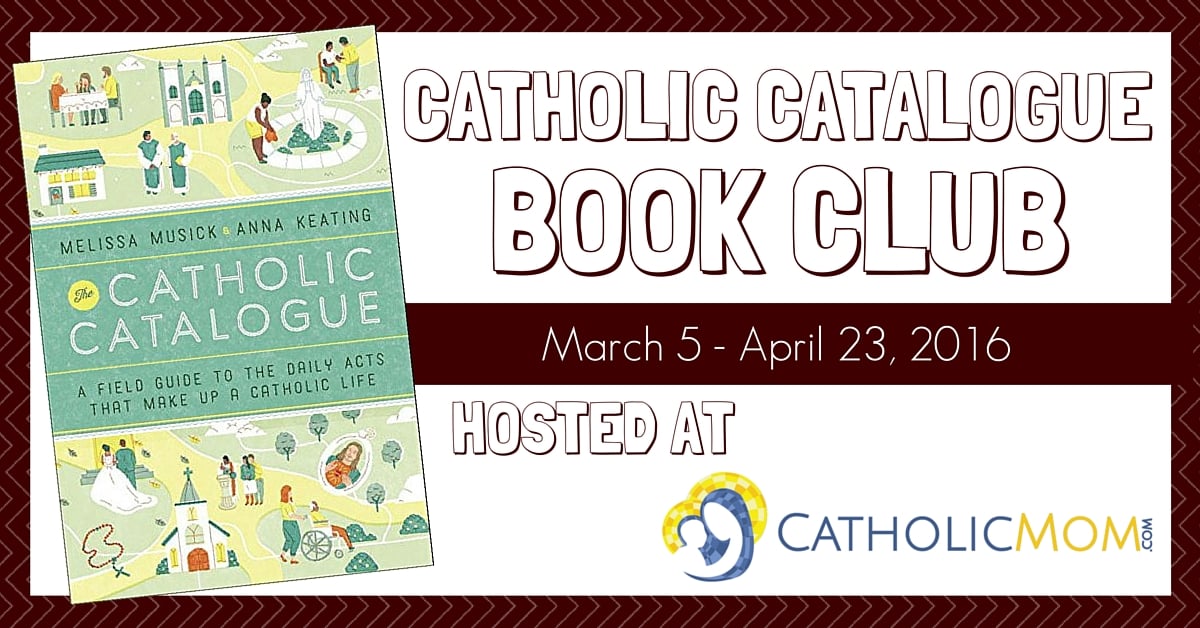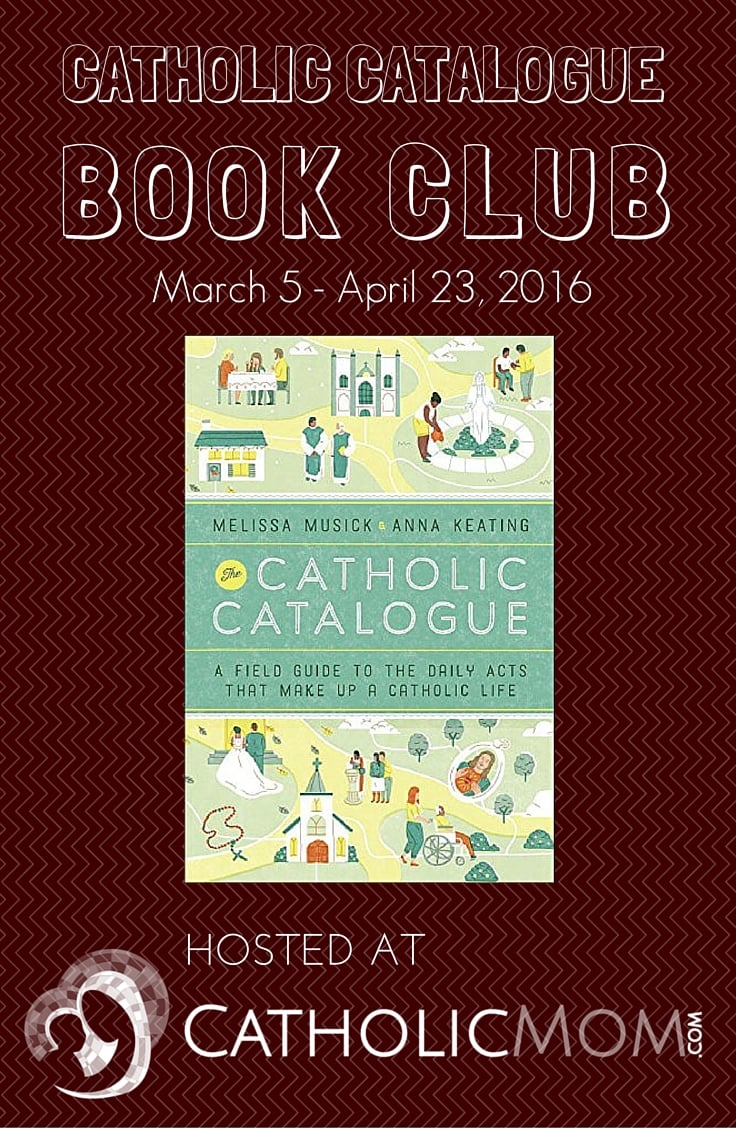Welcome to the Catholic Catalogue Book Club! We're reading The Catholic Catalogue, by Melissa Musick and Anna Keating.

Over the last two months of Catholic Catalogue Book Club posts, I've noticed a running theme in my fellow writers' commentary.
It's a profound appreciation for the way this book catalogs (hence the name right?) the ways everyday Catholic life can be infused with Catholic faith.
Catholicism is not merely a Sunday religion…and this is its beauty.
As Catholics, we have an inheritance. It's accrued over thousands of years. Millions of faithful, worshiping Catholics have contributed to it over time. It's this treasure of rituals, routines, and celebrations that penetrate the fabric of daily Catholic living.
Catholicism is more than a set of doctrines to be learned. It's more than a worship service once a week or a set of rules to be observed.
Catholic life has rhythms that are saturated with the sacred. For parents, there's no better way to nurture your child's faith than by keeping these rhythms. Smells and bells are powerful catechesis that sear faith into the souls of young Catholics.
In this post I'm batting cleanup, commenting on the closing chapters of the book, and Catholic life, with the Seasons of Life in Adulthood.
Marriage and Consecrated Virginity
Musick and Keating begin Part Three with vocations.
Vocations are an important part of Catholic life. They're how we are called to live out our life and service to God.
I loved this juxtaposition between secular and Catholic ideas of marriage:
"American culture sets a high bar for weddings"
"The Catholic Church sets a high bar when it comes to marriage" (p. 361).
The authors make the point that marriage, like everything else in Catholic life, is saturated with the sacred. It's not simple the legal binding of two persons, it's the spiritual blending of two lives. Spouses are "surrendering their radical independence and becoming…'one flesh'" (p. 362).
Modern culture idealizes love. The Church upholds love and fidelity.
"Is it possible to be faithful to one person for a lifetime and actually be happy? Marriage is hard. People change. No one knows what the future holds" (p. 364).
"And yet many married people say that being married for life is possible precisely because being married is not about perfection" (p. 364).
Marriage is not about perfection. It's about imperfection…more precisely, the forgiveness and acceptance of it in your spouse and in yourself. Marriage demands self-gift and change, the letting go of narcissism and immaturity. It's only possible with grace, which is why marriage is a sacrament.
Another vocation we may experience in our adulthood, that is not a sacrament, is consecrated virginity.
I was eager to read this one because I didn't fully understand it. I've seen consecrated virgins, and I knew it was a thing, but I didn't get how they fit. Why not be a nun?
But it made sense when I read that consecrated virgins often have other occupations not necessarily associated with the Church. They live ordinary lives in the midst of the world while making a radical gift of themselves to God in celibacy.
Without families or other responsibilities, they are freed to form deeper friendships and take more risks for the Gospel. They are liberated to go where God calls them...anywhere in the world and in any part of society.
Family life as sacred space
If the sacred does saturate daily Catholic life, then that certainly extends to your home.
We typically underestimate how much our surroundings influence decisions and behavior. We routinely turn to books or classes to reinforce thought patterns or change habits. However, psychologists and change experts say social and environmental factors also influence what we choose and how we live. Your home environment can and should influence you and your family's growth in holiness.
Some suggestions from the authors include blessing your new home, setting up a prayer corner or shrine, and decorating with religious art. You could set up a closet or small room as a quiet prayer retreat or make it a place to display family keepsakes like First Communion photos.
Change your home decorations to reflect the liturgical season. Display different colors, like purple during Lent for instance, or bring out certain pieces of art for a favorite saint's feast day.
Another great idea from the book is Catholic road trips--visiting holy site pilgrimages while on family vacation.
Blessings are a must for sanctifying family life. The authors point out that some blessings, such as a church altar or religious medal, can only be done by priests. However, because of the "special office" that comes from "their care and oversight of children," parents can give blessings to their kids.
Suffering and Death
Of course, a Catholic guide to the rhythms of life would be incomplete without a section on death. It's so very Catholic to consider suffering and dying within a discussion of how to live. To me, it's one of things that makes Catholicism shine.
Suffering is a part of every life at one time or another, and we're all going to die. Most people live in denial of this. Their prayer is that it just never happens. Then once it does, there's no consolation, no mechanism for dealing with the reality. But Catholicism finds meaning and purpose in suffering.
"We have to understand that sickness and death do not enter the world through God's will or God's design…[they] come as a result of sin"...[however] "Christians know there is power in suffering" (p. 399).
We can join our suffering to Jesus' and cooperate in his redemptive self-offering. In our weakest time, we are most strong and most effective. Now I'm not volunteering, but if/when I have my turn in the barrel, I'll know that my suffering will not be in vain or useless.
To help with all this, there is the Anointing of the Sick. This sacrament is meant to strengthen you to suffer well and offer your pain for the salvation of others. Musick and Keating also speak about the comfort and solace brought by rituals and prayers for the dying. As well, there is Viaticum, the last reception of the Eucharist that serves to spiritually strengthen the dying in their final moments.
Last, there's the Funeral Mass. Unlike secular "life celebrations," this is not merely a sad memorial of a life ended. It's an act of worship that reminds us of "Christ's victory over death" and the hope of sharing in Christ's glory with our loved one, reunited for all eternity.
This book is truly a gift. A catalog of our patrimony, our rich inheritance of Catholic culture. Every Catholic family should have this book and use it to create a home life saturated with the sacred. I will definitely recommend it to anyone interested in infusing the treasure of Catholic thought and practice into their lives.
To Ponder, Reflect, and Discuss:
- What readings and music did you pick for your wedding? Did you choose something special, like the authors mentioned, that communicated the hope for your new married life?
- Did you have your home blessed? What are your favorite Catholic home decorations? Do you have a home altar, shrine, or prayer corner? Does your home decor change to reflect the different liturgical seasons?
- Do you take Catholic road trips or pilgrimages as a family? What was your favorite?
- Do you bless your children regularly? What wording do you use for the blessing?
Feel free to comment on your own thoughts from this week's reading, your impressions and reflections, and/or your answers to these questions.
Thanks so much for being part of the discussion! This concludes our Book Club. Visit (and share!) the Catholic Catalogue Book Club page for the complete list of our posts.
Copyright 2016 Marc Cardaronella

About the Author

Marc Cardaronella
Marc Cardaronella is the author of Keep Your Kids Catholic: Sharing Your Faith and Making It Stick from Ave Maria Press. Marc directs catechist and discipleship leader formation for the Diocese of Kansas City-St. Joseph, MO. He is married, has two teen boys, and writes about Catholic spirituality and how to share the Faith on his personal blog.


.png?width=1806&height=731&name=CatholicMom_hcfm_logo1_pos_871c_2728c%20(002).png)
Comments